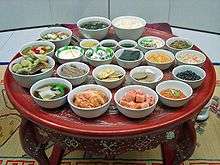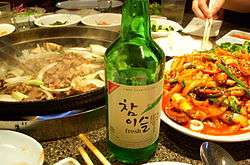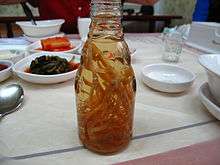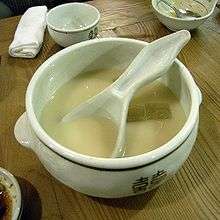Korean alcoholic beverages
| Korean alcoholic beverages | |
| Hangul | 술 / 주 |
|---|---|
| Hanja | 술 / 酒 |
| Revised Romanization | sul / ju |
| McCune–Reischauer | sul / chu |
 |
| This article is part of a series on |
| Korean cuisine 한국 요리 조선 료리 |
|---|
|
Staples |
|
|
Korean culture has a wide variety of traditional alcoholic beverages, most of which are called by the Sino-Korean term ju (hangul: 주; hanja: 酒).
Origin
Goguryeo was the northernmost of the three kingdoms on the Korean peninsula from the 3rd century to the 7th century (the Three Kingdoms Era). Archaeological evidence indicates that the Goguryeo culture had a highly developed tradition of fermented foods and drink. At that time they made drinks using nuruk (fermentation mix) and malt. The methods used today were developed 5,000 years ago. Recorded methods of making sul date from as early as A.D. 430.
Baekje was the second of the Three Kingdoms and it dominated the southwestern part of the peninsula. Sul was introduced to Japan from Baekje by a Susubori (Korean for brewer) named Inbon,[1][2] who became the Japanese god of drink.[3] According to an old Japanese archival text "Ground Rice," Susubori offered sul to a Japanese king. This was the king's first taste of alcohol and it made him joyous and he sang aloud.
Silla was the third of the Three Kingdoms, dominating in the southeast region and eventually unifying the peninsula in the 7th century. Silla was a younger state and was at first less developed than Goguryeo and Baekje. This included their sul making techniques. However, Silla rapidly caught up with its older neighbors in all areas. The Silla text 'Jibung Yuseol' gives evidence of Silla's sul making tradition.
In Jewang ungi, a history book during the Goryeo Dynasty, a myth regarding the origin of alcoholic drinks appears. Once upon a time, there was a king who enjoyed using alcohol to tempt a woman to want to have many children. When their son was born, they named him Sul. The word sul (hangul: 술), referring to alcoholic beverages, came from a blending of the words "su" (hangul: 수; hanja: 水) and "bul" (hangul: 불), meaning "water" and "fire", respectively. That is, "firewater" originated from the boiling liquid.[4] This is popular etymology at best.
The production and demand for traditional Korean wines and liquors declined sharply beginning during the colonial period. In 1986, in an effort to remedy this situation, the Cultural Heritage Administration of South Korea selected 86 varieties of traditionally brewed alcoholic beverages as cultural properties, with twelve types selected as Important Intangible Cultural Properties of Korea, each hailing from its own locality.
Varieties
In Korea, the major crop has historically been rice, and thus most Korean traditional alcoholic beverages are rice wines, made from both glutinous rice and non-glutinous rice. These are fermented with the aid of yeast and nuruk, a wheat-based source of the enzyme amylase. Additionally, Koreans often use fruits, flowers, herbs, and other ingredients to flavor these beverages, to a much greater extent than Chinese wines.
There are six main types of Korean alcoholic beverages: yakju, distilled liquors (including soju), takju, fruit wines, flower wines, and medicinal wines.
Yakju

Yakju (hangul: 약주; hanja: 藥 酒; literally "medicinal alcohol") is a refined rice wine made from steamed rice that has gone through several fermentation stages. It is also called myeongyakju or beopju and is distinguished from takju by its relative clarity.
Varieties include baekhaju (백하주), which is made from glutinous rice and Korean nuruk, and Heukmeeju (hangul: 흑미주; hanja: 黑米酒; literally "black rice wine"), which is made from black rice.
Cheongju
Cheongju (hangul: 청주; hanja: 淸 酒; literally "clear wine" or "clear liquor") is a clear rice wine similar to Japanese sake. One popular brand of cheongju is Chung Ha (청하), which is widely available at Korean restaurants. There are various local variations, including beopju, which is brewed in the ancient city of Gyeongju.[5]
Distilled liquors
Korean distilled liquors include goryangju (hangul: 고량주; hanja: 高梁酒; also spelled koryangju; made from sorghum and similar to Chinese gaoliang jiu) and okroju (hangul: 옥로주; hanja: 玉 露 酒; made from rice and Job's Tears). Another variety, called munbaeju (문배주), has the distinction of being South Korea's Important Intangible Cultural Property Number 86‑1. Munbaeju is a traditional aged distilled liquor made of malted millet, sorghum, wheat, rice, and nuruk (fermentation starter), with a strength of 40 percent alcohol by volume. It originates in the Pyongyang region of North Korea and is noted for its fragrance, which is said to resemble the flower of the munbae tree (similar to a pear).[5][6]
Soju

Soju (hangul: 소주; hanja: 燒 酒; lit. "burnt liquor"), a clear, slightly sweet distilled spirit, is by far the most popular Korean liquor. Koreans call soju "a friend of life" and "common people's drink". It is made from grains such as rice, barley and wheat, or from starches such as potatoes, sweet potatoes and tapioca. Soju is often compared to vodka, but it has a sweet taste due to the added sugar. The drink is usually served neat and in a shot glass, and it should be drunk as a shot or sipped on. It is smooth and clean in taste, which makes it easy to pair with a variety of Korean dishes. It is generally inexpensive. A typical bottle of soju costs about 1,000 won, less than 1 dollar. It typically has an alcohol content of 40 proof (20% alc. by volume). There is a version with top notch ingredients distilled using traditional methods that hails from the city of Andong that is 90 to 100 proof (45 - 50% alc. by volume). This version has a government protection/regulation seal, as Andong has historically been known as a center of fine soju among other things. While all soju in Korea are priced almost identically (inexpensively as previously mentioned), Andong soju commands more than 20 times that price. It is the cognac to commercial soju's vin du pays.
In the 13th century, during the Goryeo Dynasty ruling, Mongol invaders brought their soju, known as "araki" with them. "Araki" comes from the Arabian term "araq", which means distilled liquor. Thus soju was originally developed in Arabia and passed through Mongolia before it made its way to Korea. Koreans had never before encountered distilled liquor, as they were accustomed to drinking fermented alcoholic beverages such as makgeolli. Mongol base camps, such as Kaesong, Andong, and Jeju Island, are now famous soju producing regions. ("Koreana:A Quarterly on Korean Art & Culture", 2016).
In the late 20th century soju flavored with Lemon or Green tea became available. Soju mixed with beer is called somaek (소맥) and is widely popular. The Japanese version is called Shōchū.
Makgeolli
Makgeolli (막걸리), also known as takju (hangul: 탁주; hanja: 濁酒;named for its dull white color), is a milky, sweet alcoholic beverage made from rice. It is also called nongju (hangul: 농주; hanja: 農酒; lit. "farmers' alcohol"). Makgeolli is one of the most popular alcoholic beverages in Korea. It is the oldest traditional Korean rice wine, with a 6 - 7% alcohol content. It is fermented naturally and unfiltered which gives it its milky white color and makes it chalky at the bottom. The beverage is thick but smooth. It tastes sweet with a slight tang and leaves a cool aftertaste. It is served in a bowl rather than a cup. A good makgeolli will blend well with most side dishes.
It is unclear when Koreans began to drink makgeolli but according to "Poetic Records of Emperors and Kings," written during the Goryeo Dynasty (A.D. 918-1392), the drink was first mentioned in the founding story of the Goguryeo Kingdom during the reign of King Dongmyeong (B.C. 37 - B.C. 19). (KOCIS, 2016).
Makgeolli is brewed using classical methods with koji or nuruk(molded cereals that produce hydrolysable enzymes that decompose macromolecules to monomers for yeast growth) cooked rice, water, barley and yeasts. (Choi et al., 2014). The brewing process consists of two steps: seed mash and main mash or main fermentation. Seed mash is the stage of obtaining actively growing yeasts and enzymes in the mixture of yeast and koji or nuruk. The purpose of main mash is to acquire taste and aroma intrinsic by the transformation of nutrients and amino acids derived from the rice. Main fermentation lasts about a week. (Kang, Lee, & Park, 2014).
Thanks to its fermentation process using microorganisms, it is both a liquor and a health drink. It contains 1.9% protein, over 10 amino acids, along with vitamin B, inositol and choline. Makgeolli is known for boosting metabolism, relieving fatigue, and bettering one’s complexion. (KOCIS, 2016).
A regional and slightly creamier variant, originally from Gyeonggi-do, is called Dongdongju. Another variety, called ihwaju (hangul: 이화주; hanja: 梨 花酒; literally "pear blossom wine") was so named because it was brewed from rice with rice malt that had fermented during the Pear blossom season. Ihwaju is often so thick that it must be eaten with a spoon. Many farmers like to drink these alcoholic beverages when they work in rice paddies.
A similar drink is called Gamju; this name is also used for various non-alcoholic sweet drinks including Sikhye (식혜).
Fruit wines

Korea has a number of traditional fruit wines, produced by combining fruits or berries with alcohol. Podoju (포도주, 葡萄酒) is made from rice wine that is mixed with grapes. The most popular fruit wines are made from maesil plums (such wine called maesil ju, mae hwa su, mae chui soon, or Seol Joong Mae), bokbunja (복분자, Korean black raspberries, Rubus occidentalis L., 15% alcohol), Chinese quinces, cherries, pine fruits, and pomegranates. A wine tunnel south of Daegu produces a slightly tart wine made from persimmons.


Flower wines
There are a number of Korean traditional wines produced from flowers. These include wines made from chrysanthemums, called gukhwaju (국화주, 菊花酒; marketed by Jinro as Chun Kook), acacia flowers, maesil blossoms (maehwaju, 梅花酒), peach blossoms (dohwaju, 桃花酒), honeysuckle (indongju, 인동주, 忍冬酒), wild roses, and sweet briar petals and berries.[7]
Dugyeonju (두견주, 杜鵑酒) is a wine made from Azalea petals, produced in Chungcheong Province. It is sweet, viscous, and light yellowish brown in color, and contains about 21% alcohol. Myeoncheon Dugyeonju is designated by the South Korean government as Important Intangible Cultural Property No. 86-2.[8]
Another variety of flower wine, called baekhwaju (hangul: 백화주; hanja: 白花酒), is made from 100 varieties of flowers.[9]
Medicinal wines

Medicinal liqueurs, called yagyongju (약용주, 藥用酒) are produced by combining medicinal seeds, herbs, and roots with alcohol.
- Bek Se ju (Baekseju; hangul: 백세주; hanja: 百歲酒; literally "100 years wine") is a commercial variant of medicinal wine, and is the most popular medicinal wine for younger people, who generally do not drink it primarily for its medicinal properties. It has become a popular alternative to soju in most restaurants and drinking establishments. It is a rice wine infused with ginseng and eleven other herbs, including licorice, omija (Schisandra chinensis), gugija (Chinese wolfberry), Astragalus, ginger, and cinnamon, and is 13% alcohol.
- Beolddeok ju (벌떡주; lit. spring-up wine[10]); a rice wine infused with herbal medicines and sweetened with pumpkin malt that is believed to increase male stamina. The bottles are often sold topped with a ceramic penis with a smiling face.[11][12]
- Bem ju (뱀주) literally "Snake Wine" is made by placing a snake in a jar of distilled liquor like Soju and aging it. It is a folk remedy that is said to be particularly "good for men." Various types of snakes are used. Local lore has it that the more venomous the snake, the more powerful the medicinal quality (and the higher the price).
- Chuseongju (hangul: 추성주; also spelled chusungju) is a traditional wine made from glutinous and non-glutinous rice, herbs including omija (Schisandra chinensis) and Eucommia ulmoides; it is commercially available in a bamboo-shaped bottle.
- Daeipsul (대잎술) is another traditional folk wine from Damyang County, South Jeolla Province, made from glutinous rice, brown rice, and bamboo leaves, along with ten medicinal herbs.
- Dosoju (hangul: 도소주; hanja: 屠蘇酒) is a popular herbal wine, traditionally served only on New Year's Day.[13]
- Insamju (인삼주, 人蔘酒), made with Ginseng, is the most popular medicinal wine among older people.[14]
- Jugyeopcheongju (hangul: 죽엽청주; hanja: 竹葉青酒) is a traditional liquor made with Bamboo leaves.
- Ogalpiju (오갈피주; hanja: 五加皮酒) is made from the bark of Eleutherococcus sessiliflorus blended with soju and sugar.
- Sansachun (산사춘) is another commercial Korean wine made from the red fruits of the sansa, or Chinese hawthorn (Crataegus pinnatifida). The Bae Sang Myun Brewery Company markets this wine, claiming therapeutic effects.
- Songsunju (hangul: 송순주; hanja: 松筍酒) is soju made with glutinous rice and soft, immature pine cones or sprouts.[15][16]
Other wines
- Yuju or mayuju (hangul: 마유주; hanja: 馬 乳 酒), which is made from fermented Horse milk, was introduced to Korea from Mongolia. It is similar to kumis.
Beer
Beer (called maekju; hangul: 맥주; hanja: 麥 酒 in Korean) was introduced to Korea by Europeans and there are several breweries in South Korea.
See also
- Ear-Quickening wine (at Korean language Wikipedia)
- Icariine Liquor
- Korean cuisine
- List of Korea-related topics
- List of rice beverages
References
- ↑ 우리나라 술의 발달사. 신광출판사. 2004. p. 55. ISBN 9788970697581.
- ↑ "되살아난 우리 전통 술... 이젠 '酒道'도 되살릴 때". The Chosun Ilbo Senior. 12 July 2012. Retrieved 26 April 2013.
- ↑ Lee Hyo-gee (1996). "History of Traditional Korean Alcoholic Drinks". Koreana, Vol. 10. No.4. Archived from the original on 30 April 2009.
- ↑ "History of Korean Alcohol". Life in Korea. Retrieved 18 June 2008.
- 1 2 Traditional Liquor Korea Tourism Organization. Retrieved 28 August 2009
- ↑ "Drinks of the Ancients". SkyNews. Retrieved 27 May 2016.
- ↑ "Flower Pancakes and Flower Liquor : Traditional Food with a Floral Fragrance". Koreana. 2003. Archived from the original on 28 September 2007.
- ↑ "Drinks of the Ancients". Sky News. Retrieved 30 April 2013.
- ↑ "Bottoms up for tip-top health". Korea JoongAng Daily. 27 May 2003. Retrieved 30 April 2013.
- ↑ "벌떡". Naver English Dictionary. Naver Corporation. Retrieved 15 September 2015.
- ↑ "A Taste of the Sea and the Mountain". Koreataste. Korea Tourism Organization. 19 September 2011. Retrieved 28 August 2015.
- ↑ Seo (서), Bu-won (부원) (11 March 2010). "'남근목' '벌떡주'...예스럽던 동해안은 어디로 갔나" (in Korean). OhmyNews. Retrieved 28 August 2015.
- ↑ 도소주 (in Korean). Korean Folk Encyclopedia. Retrieved 30 April 2013.
- ↑ Pettid, Michael J. (2008). Korean cuisine: an illustrated history. China: Reaktion Books Ltd. pp. 110–123. ISBN 9781861893482.
- ↑
- ↑ 송순주담그기 (in Korean). Korean Folk Encyclopedia. Retrieved 30 April 2013.
- Kang, Bo-Sik; Lee, Jang-Eun; Park, Hyun-Jin (2014-06-01). "Qualitative and Quantitative Prediction of Volatile Compounds from Initial Amino Acid Profiles in Korean Rice Wine (makgeolli) Model". Journal of Food Science. 79 (6): C1106–C1116. doi:10.1111/1750-3841.12489. ISSN 1750-3841.
- Choi, Jae-Suk; Lee, Yu-Ri; Ha, Yu-Mi; Seo, Hyo Ju; Kim, Young Hun; Park, Sun-Mee; Sohn, Jae Hak (2014-06-01). "Antibacterial Effect of Grapefruit Seed Extract (GSE) on Makgeolli-Brewing Microorganisms and Its Application in the Preservation of Fresh Makgeolli". Journal of Food Science. 79 (6): M1159–M1167. doi:10.1111/1750-3841.12469. ISSN 1750-3841.
- (KOCIS), Korean Culture and Information Service. "Say hello to the latest Korean fervor - makgeolli the rice wine :: Korea.net : The official website of the Republic of Korea". Retrieved 2016-07-17.
- "Koreana : a Quarterly on Korean Art & Culture". www.koreana.or.kr. Retrieved 2016-07-18.
External links
| Wikimedia Commons has media related to Alcoholic beverages from Korea. |
- "History of Korean Alcoholic Drinks". Archived from the original on 30 April 2009.
- Traditional Korean alcohol
- Drinks of the Ancients
- Shrine to Spirits: Chiew and soju
- Traditional Korean Liquors
- Korean Alcoholic Beverages of the World
